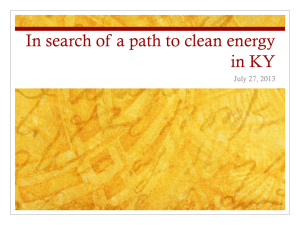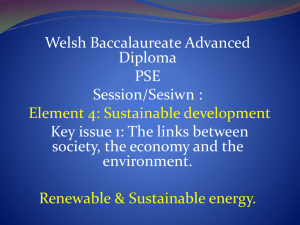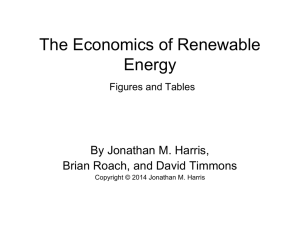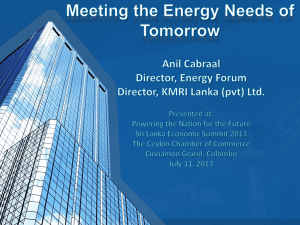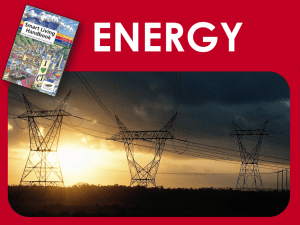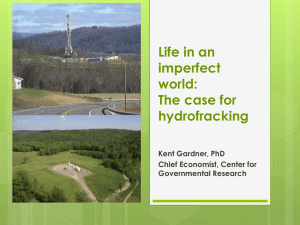Renewable Energy - CEMS Research Homes
advertisement
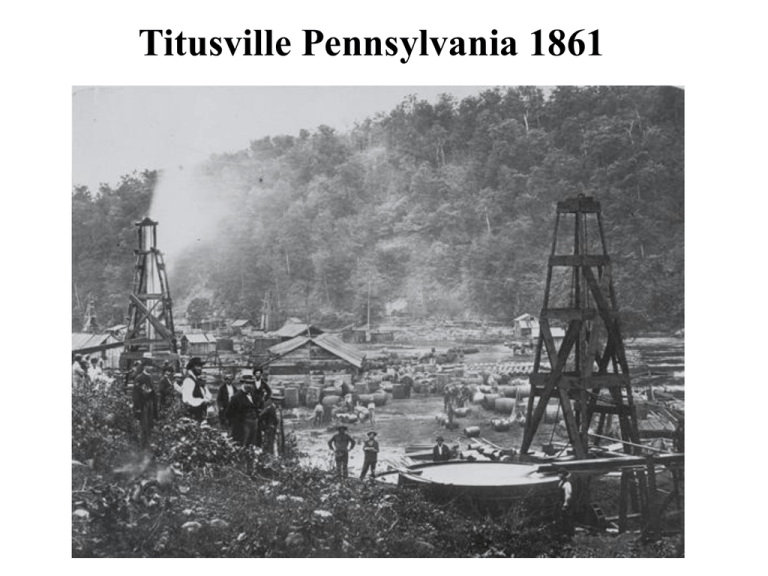
Titusville Pennsylvania 1861 Gulf of Mexico 2010 Renewables Change the Game overfunctionalized feedstocks distributed sources local supply and demand monopolies difficult to establish no intermediaries local economic ecosystems new technologies needed Survey of Renewable Energy Technologies ChE 5551 Tuesday and Thursday 2:30-3:45 pm 2010 Amundson B75 Homework assignments weekly mass and energy balances and Web searches Several short papers Two one-hour exams Visitors welcome Friendly to non chemical engineers Survey of Renewable Energy Technologies Energy sources and uses Biomass Chemical processing Biological processing Wind energy Energy storage and sequestration Efficiency Renewable chemicals Engines and combustion Fuel cells Environment Economics Tentative Schedule Sept Oct Nov Dec 7 9 14 16 21 23 28 30 5 7 12 14 19 21 26 28 2 4 9 11 16 18 23 25 30 2 7 9 15 energy uses energy sources biomass lignocellulose agriculture coal, petroleum, and gas biorefining gasification pyrolysis ethanol ethanol economics biodiesel catalysis methanol and DME FT alkanes biochemicals fermentation exam biological processing electricity wind and hydro coal gasification photovoltaics fuel cells climate change Thanksgiving efficiency energy policy Last day Engineering Topics thermodynamics kinetics combustion reactor engineering catalysis process flow sheets Subjects will be introduced and equations given in lecture. The Subject of this Course source coal petroleum biomass wind sun process chemical thermal biological mechanical product heat chemicals electricity fuel Suggested Books Sustainable Energy: Choosing Among Options, Jefferson W. Tester, Michael Driscol, and Elizabeth M. Drake, 2005 Energy and the Environment, J. A. Fay and D. S. Golomb, Oxford, 2002 Introduction to Energy, E. S. Cassidy and P. Z. Grossman, Cambridge, 1998 Engineering Response to Global Climate Change, R. G. Watts, CRC, 1998. Bioenergy - Realizing the Potential, S. Silveira Gasification Technologies: A Primer for Engineers and Scientists, J. Rezaiyan Green Chemistry, Mike Lancaster Wind Power in Power Systems, T. Ackerman Biodiesel: Growing an New Economy, G. Pahl The Renewable Energy Handbook: A Guide to Rural Independence, W. H. Kemp Alternative Energy Sources: The Quest for Sustainable Energy, Paul Kruger, 2006 Fundamentals of Renewable Energy Processes, Aldo V. Da Rosa, 2005 Renewable Energy Resources, 2nd ed., John Twidell and Anthony Weir Renewable Energy, Godfrey Boyle, ed., 2004 Catalysis for Renewables: From Feedstock to Energy Production, Gabrielle Centi and Rutger van Santen, ed., 2007 Synthetic Fuels, R. Probstein and R. E. Hicks, 2005 Some Interesting Books: The Prize, Daniel Yergin Seven Sisters, Anthony Sampson The Hype about Hydrogen, Joseph Romm The Future of Hydrogen, Jeremy Rifkin Out of Gas: The end of the Age of Oil, David Goodstein Skeptical Environmentalist: Measuring the Real State of the World, Bjorn Lomborg An Inconvenient Truth, Al Gore and Albert Gore Renewable Energy Policy, Paul Komor The Party’s Over: Oil, War, and the Fate of Industrial Societies, Richard Heinberg Long emergency: Surviving the converging Catastrophe in the 21st Century, James H. Kunstler American Theocracy: The Peril and Politics of Radical Religion, Oil, and Borrowed Money in the 21st Century, Kevin Phillips Twilight in the Desert: The Coming Saudi Oil Shock and the World Economy, Matthew R. Simmons Alcohol Can Be A Gas: Fueling an Ethanol Revolution for the 21st Century David Blume, 2007 Beyond Oil, K. F. Deffeyes, 2005 Some Interesting Books: Sleeping with the Devil: How Washington Sold Our Soul for Saudi Crude, Robert Baer Conspiracy of Fools: A True Story, Kurt Eichenwald The End of Oil: On the Edge of a Perilous New World, Paul Roberts Beyond Oil: The View from Hubbert’s Peak, Kenneth S. Deffeyes The Bottomless Well: The Twilight of Fuel and Why We will Never Run Out of Oil, Peter Huber A Thousand Barrels a Second, Peter Tertzakian Big Coal: The Dirty Secret Behind America’s Energy Future, Jeff Goodell Energy in World History, Vaclav Smil (1995) The Botany of Desire, Michael Pollan The Omnivore’s Dilemma, Michael Pollan Coal: A Human History, Barbara Freese (Minnesota author) Fossil Fools, Joe Shuster (ChE MN graduate) Green Hell : How Environmentalists Plan to Control Your Life and What You Can Do to Stop Them Red Hot Lies : How Global Warming Alarmists Use Threats, Fraud, and Deception to Keep You Misinformed Renewable versus Nonrenewable Coal, oil, gas, and biomass CHx + O2 CO2 + H2O + heat These all came from photosynthesis CO2 + H2O + sunlight carbohydrates +O2 plants animals energy CO2 No net CO2 produced in cycle The cycle takes 1 year for crops 200 million years from coal and oil! Mato Grosso Brazil Soybean Harvest and Corn Planting University Windmill at Morris The Subject of this Course source coal petroleum biomass wind sun process chemical thermal biological mechanical product heat chemicals electricity fuel ENERGY PRODUCTION time wood coal whale oil petroleum hydroelectric nuclear natural gas process corn soy beans crop residues wood residues energy crops municipal solid waste algae solar thermal photovoltaic transportation fuels (T) chemicals (C) value power (E) heat (H) SOURCES time wood HTE coal HTE whale oil L petroleum TCH hydroelectric E nuclear E natural gas HE process corn T soy beans T crop residues wood residues energy crops municipal solid waste algae solar thermal E photovoltaic E transportation fuels (T) chemicals (C) value power (E) heat (H) RENEWABLE wood hydroelectric natural gas corn soy beans process crop residues wood residues energy crops municipal solid waste algae solar thermal photovoltaic transportation fuels (T) chemicals (C) power (E) heat (H) BIOMASS wood corn soy beans natural gas process crop residues wood residues energy crops municipal solid waste algae transportation fuels (T) chemicals (C) power (E) heat (H) GENERATION I corn soy beans process corn ethanol biodiesel GENERATION II wood crop residues wood residues process natural gas energy crops municipal solid waste algae transportation fuels (T) chemicals (C) power (E) heat (H) Energy may be the most important technological problem of the 21st Century The biological revolution cannot happen without the energy to drive it Most wars are fought over energy Energy must be stored chemically Biomass must be the source Minnesota spends $12 billion/year on imported energy Why Examine Renewables? Chemical engineering petroleum Mechanical engineering power systems and engines Agricultural engineering farm production Agriculture food and feed crops Biology food and drug processing History of Renewable Energy before 1600 wood horses all renewable Industrial Revolution steel coal hydro 1850 whaling 1900 petroleum electricity petrochemicals after 2000 ? Titusville Pennsylvania 1861 A Quiz What do the following have to do with energy? Moby Dick 1851 Stanley Steamer 1907 Pearl Harbor 1941 Our Ancestors Used Renewables Wood heat Beeswax and tallow light Wool, cotton, and leather clothing Horses transportation (eats oats, fertilizes the soil, and produces colts) These are completely renewable as long as they are sustainable All agricultural based products The Industrial Revolution demanded a transportable liquid fuel Whale oil was the 19th Century solution whales not renewable fast enough Petroleum became the replacement gasoline, diesel, and jet fuel 10% converted into petrochemicals The energy engine of the world economy most located in bad places Saudi Arabia, Iraq, and Russia World Climate Solar Flux Solar Flux Solar Flux Hubbert’s Peak Hubbert’s Peak US Fort McMurray Tar Sands Rough Values of Power of Various Processes (watts) Solar power incident on earth 1017 Solar power avg. on U.S. 1015 Solar power consumed in photosynthesis 1014 U.S. power consumption rate 1013 U.S. electrical power 1012 Large electrical generating plant 109 Automobile at 40 mph...105 Solar power on roof of U.S. home 104 U.S. citizen consumption rate 104 Electric stove 104 Solar power per m2 on U.S. surface 1342 watts m-2 about 1000 watts m-2 at high noon on the ground, and on average (day and night) about 240 absorbed at the ground. 102 One light bulb 102 Food consumption rate per capita U.S. 102 Electric razor 101
